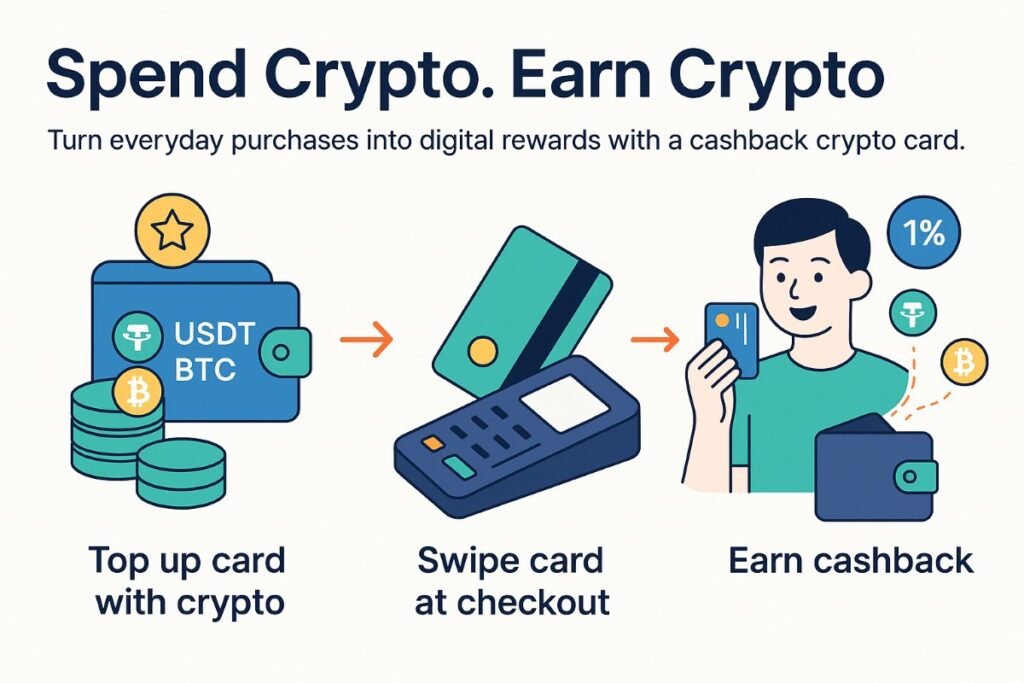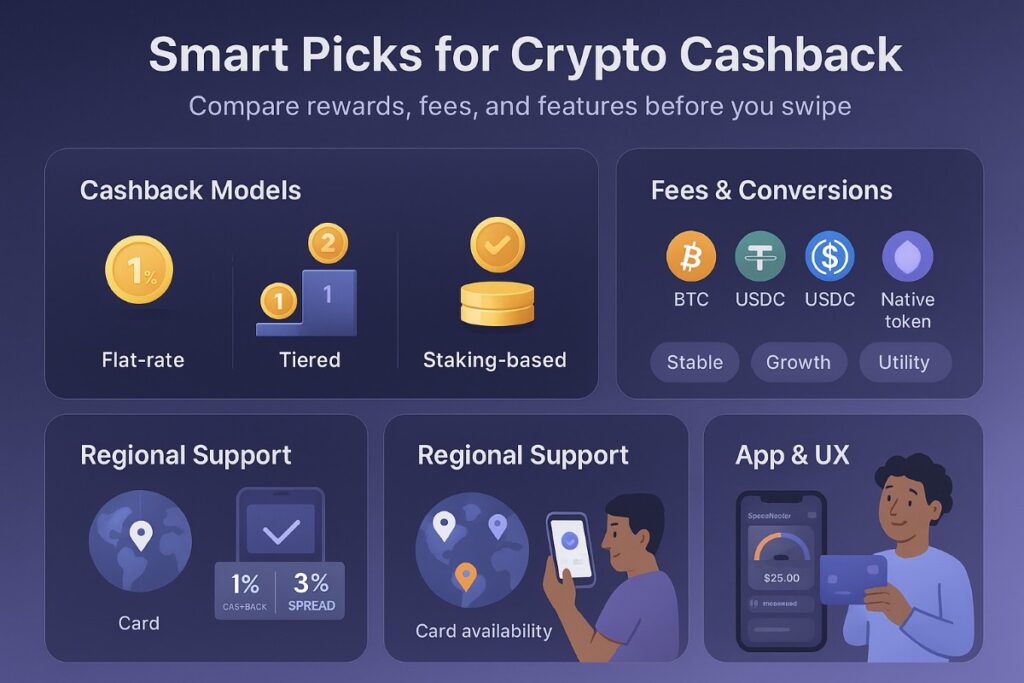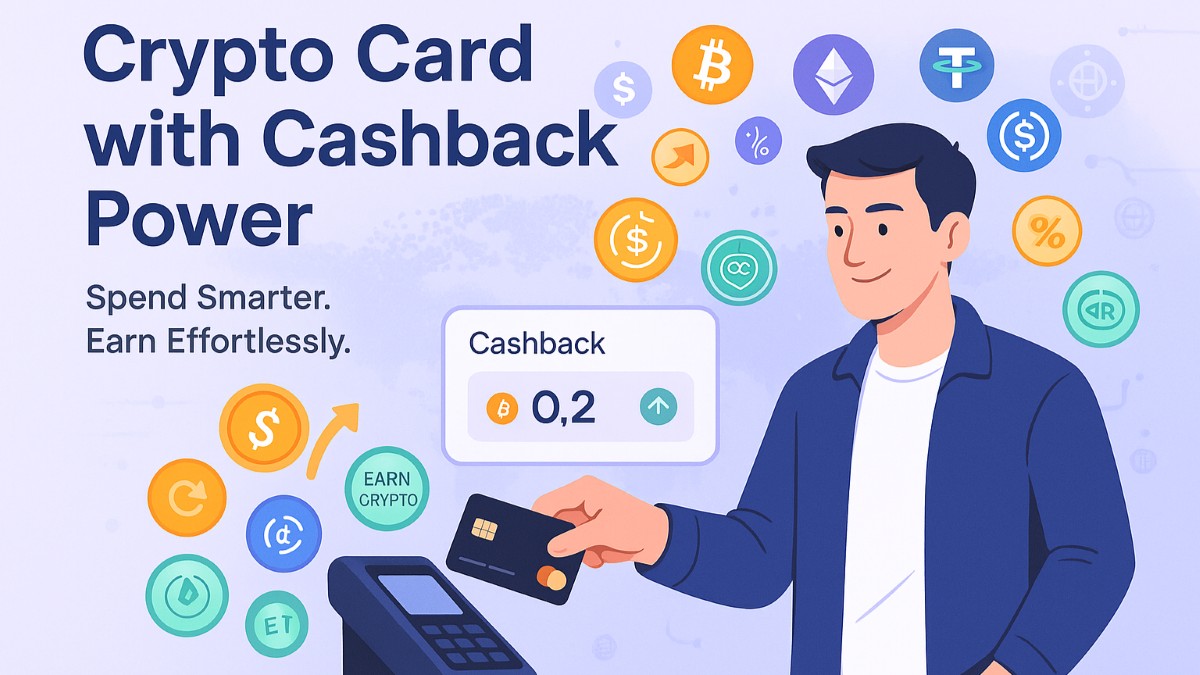In crypto, every sat counts. Whether you’re buying snacks with USDT or booking flights using ETH, a cryptocurrency card with cashback helps you earn rewards while spending your coins. These cards don’t just make crypto practical — they give it power.
A crypto card with cashback works like a bridge between digital and traditional finance. It lets users spend crypto in real-life scenarios while earning rewards, usually paid out in tokens like BTC or stablecoins. For mid-level crypto traders, this means turning everyday expenses into opportunities for passive income — all without needing to liquidate manually.
But how does it really work? What’s the smartest way to choose one? And how can you make the most of your rewards? Let’s dive in.
What Is a Cashback Crypto Card and How Does It Work?

A crypto cashback card is usually a debit or prepaid card linked to your crypto balance. It allows you to spend digital assets just like fiat, and in return, you get cashback — often in the form of cryptocurrency. Here’s what typically happens:
- You top up the card with your crypto (like USDT or BTC).
- When you swipe or tap the card at checkout, the crypto is instantly converted to fiat.
- You receive a small portion of the purchase amount back, usually in crypto.
For example, a trader might use their card for daily coffee runs or monthly subscriptions. If they earn 2% cashback on those purchases, it adds up over time — and if the market moves in their favor, those earnings could grow in value.
There are several cashback models on the market. Some cards offer a flat reward rate on all purchases. Others have tiered levels, where your cashback increases based on your activity or crypto holdings. Still others require staking — locking up tokens — to unlock higher reward tiers. Regardless of the model, a cashback crypto card offers a way to turn spending into stacking.
How to Choose a Crypto Debit Card with Cashback

Picking the right crypto debit card with cashback depends on your goals, preferences, and how you typically spend. Below are the most important factors to keep in mind:
- Cashback model: Some cards offer flat-rate cashback. That means you’ll receive the same reward percentage no matter what you buy or how often you spend. Other cards offer tiered rewards. In this model, the more you spend or the more crypto you hold, the higher your cashback percentage becomes. For example, spending $1,000 per month might unlock 2% cashback instead of 1%. Staking-based models are also common. These cards require you to lock a specific amount of tokens in your account. In return, you unlock higher reward levels, sometimes reaching up to 5% cashback. But there’s a tradeoff — staking means your tokens are tied up and subject to market volatility.
- Reward currency: The currency in which you receive your cashback also matters. Some cards offer cashback in stablecoins like USDT or USDC, which helps preserve value. Others reward you with native platform tokens that might offer additional benefits. You can also find options that return rewards in BTC, which is appealing to long-term holders. If you’re focused on accumulating Bitcoin, a Bitcoin debit card with cashback might be your best option. For those looking for consistent value, a card that rewards in stablecoins can provide predictable results. And if you’re active in a particular platform’s ecosystem, rewards in their native token might give you extra utility.
- Fees and conversion costs: Watch out for hidden fees. Some cards charge for monthly maintenance, foreign transactions, or ATM withdrawals. Others may have high spreads on crypto-to-fiat conversions at the point of sale. For example, if you use your crypto card with cashback while traveling and the conversion spread is 3%, but you only earn 1% cashback, you’re actually at a net loss. Always check the full fee structure before committing.
- Regional support Not all cryptocurrency cards are available worldwide. Some platforms are restricted to specific countries or regions. Others might allow you to sign up but offer limited functionality depending on your location. Before choosing a card, make sure it supports your country. Also check whether it works for the type of transactions you plan to make — such as contactless payments, online purchases, or ATM withdrawals. Legal and tax implications may vary depending on your region.
- App and user experience: An intuitive mobile app can make a big difference. The best crypto cards offer real-time notifications, top-up options from multiple wallets, in-app security controls, and a dashboard that tracks spending and cashback earned. These features are especially useful for active users who frequently check balances or make spending decisions based on market prices. A good app makes managing your crypto debit card with cashback smooth and stress-free.
How to Use a Cryptocurrency Card with Cashback Smartly and Maximise Cashback

Owning a card is just the beginning. Smart use separates passive holders from strategic earners.
Focus spending where it matters. Use the card for predictable, high-volume expenses — groceries, fuel, subscriptions, or trading tools. If you spend $1,000 monthly and earn 2% cashback, you’ll collect $20 per month in crypto — that’s $240 annually. If that cashback is in BTC and BTC appreciates, the upside could be even greater. Traders often route business expenses through a crypto card with cashback to optimize rewards without changing their lifestyle.
Next, consider staking if it makes sense. If your card offers staking-based rewards, run the numbers. For example, staking $2,000 worth of tokens might raise your cashback rate from 1% to 5%. But ask yourself:
- Are you comfortable locking up funds for several months?
- How volatile is the staking token?
- Will you use the card enough to justify the staking requirement?
For committed users who transact frequently, staking might make sense. For casual spenders, the risk might outweigh the benefits.
Also, take advantage of promotions. Some platforms offer limited-time boosts — double cashback weekends, holiday bonuses, or rewards for spending at specific merchants. These are great opportunities to maximize earnings without changing habits.
Stay informed by subscribing to newsletters or joining communities where announcements are posted. Being early to a promotion could give your crypto debit card with cashback some serious mileage.
Avoid unnecessary conversions. Top up your card in the crypto you plan to spend. Avoid converting assets at checkout unless absolutely necessary. Some platforms charge extra for in-app swaps or apply unfavorable exchange rates.
Let’s say your bitcoin debit card with cashback gives you 1.5% cashback when spending BTC. Loading the card directly with BTC will likely offer better value than converting from ETH or USDT at the time of purchase.
Cashback rewards may be taxable depending on your country. Keep track of how much you earn, when you receive it, and what it was worth at the time. This helps you stay compliant and avoid surprises during tax season.
Use spreadsheets or export your transaction history regularly. Many cashback crypto card platforms let you filter transactions and download detailed reports — a small step that can save you headaches later.
A cryptocurrency card with cashback is more than a payment tool — it’s a practical way to put your crypto to work. For mid-level traders and enthusiasts, it adds an extra layer of value to every transaction, helping you earn while you spend.
Choosing the right card involves careful comparison of reward structures, fees, and supported regions. Once you’ve found the best fit, using it strategically — optimizing spend, taking advantage of promotions, and tracking rewards — will help you maximize returns.
Just remember that not all features are available in every country. Regulations, tax rules, and supported cryptocurrencies can vary. Before committing to any crypto cashback card, be sure to confirm that it works in your region and aligns with your financial goals.
In the right hands, a crypto debit card with cashback in Bitcoin is more than a novelty — it’s a smart strategy. Used wisely, even small purchases can turn into meaningful gains, especially if you’re earning in BTC during a bull run.
Disclaimer: This article aims to provide information to users, don’t consider it as financial, trading, and investment advice. As cryptocurrency investment carries high risks, readers need to conduct proper research and consult with a seasoned financial professional before making any decision.




%201.png)

%201.png)

%201.png)

